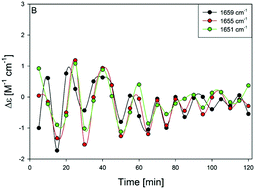Exploring the thermal reversibility and tunability of a low molecular weight gelator using vibrational and electronic spectroscopy and rheology†
Abstract
Cationic glycylalanylglycine (GAG) self-assembles into a gel in a 55 mol% ethanol/45 mol% water mixture. The gel exhibits a network of crystalline fibrils grown to lengths on a 10−4–10−5 m scale (Farrel et al., Soft Matter, 2016, 12, 6096–6110). Rheological data are indicative of a rather strong gel with storage moduli in the 10 kPa regime. Spectroscopic data revealed the existence of two gel phases; one forms below T = 15 °C (phase I) while the other one forms in a temperature range between 15 °C and the melting temperature of ca. 35 °C (phase II). We explored the reformation of the cationic GAG gel in 55 mol% ethanol/45 mol% water after thermal annealing by spectroscopic and rheological means. Our data reveal that even a short residence time of 5 minutes in the sol phase at 50 °C produced a delay of the gelation process and a gel of lesser strength. These observations suggest that the residence time at the annealing temperature can be used to adjust the strength of both gel phases. Our spectroscopic data show that the annealing process does not change the chirality of peptide fibrils in the two gel phases and that the initial aggregation state of the reformation process is by far more ordered for phase I than it is for phase II. In the gel phases of GAG/ethanol/water mixtures, ethanol seems to function as a sort of catalyst that enables the self-assembly of the peptide in spite of its low intrinsic propensity for aggregation.



 Please wait while we load your content...
Please wait while we load your content...
